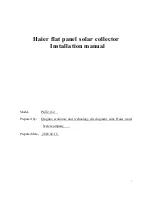
Installing the module
Make sure that the installation is carried out
safely:
Protect yourself and other persons from falling, do
not carry out the installation in heavy winds and
eliminate the risk of falling objects as much as pos-
sible. Secure the work area in order to avoid the
endangerment or injury of persons.
Observe the allowable maximum mechanical
loading:
Do not exceed the maximum mechanical loading
and make sure to consider location-specific loads
such as wind or snow. Remember that the mod-
ule might sag when loaded under certain circum-
stances. In order to avoid damaging the module by
pointed or uneven structures, do not place fasten-
ers or cable ties between the rear of the module
and the cross section.
Ensure that the modules are grounded prop-
erly:
In order to eliminate the risk of fire or electric shock
to the highest extent, the PV modules must be
grounded according to good professional practice.
The company carrying out the installation of the
PV system is also responsible for the grounding of
every individual module. For this purpose, every
module frame must be connected via the provided
grounding hole.
The grounding connections between the modules
must be checked and accepted by a qualified elec-
trician. Furthermore, the main grounding may only
be connected by a qualified electrician.
In the USA and Canada, a grounding method ap-
proved by Underwriters Laboratories (UL) is oblig-
atory.
To provide proper grounding, an optimal electrical
conductivity is required. For this purpose, ground-
ing holes at the rear of the module frame are pro-
vided. These grounding holes are marked by a
stamped ground symbol.
Grounding symbol:
Connect the grounding terminal only to the provided and
marked grounding holes at the rear of the module frame.
For grounding we recommend the Solklip ground-
ing terminal with integrated thread-cutting screw,
(UL 467 approved, UL number E69905), manu-
factured by Tyco Electronics. Observe the addi-
tional instructions at
www.tycoelectronics.com
.
These grounding terminals accommodate 4 mm²
(AWG 12) and 6 mm² (AWG 10) stripped solid cop-
per wires. The wires must not be cut, notched or
scratched. No further preparation is required. We
also recommend to use the Tyco Electronics Solar
AWG wire (UL 854). This wire is tested for outdoor
use.
23
Installation guide
Summary of Contents for S-Class Excellent Series
Page 2: ...2 Montageanleitung ...
















































